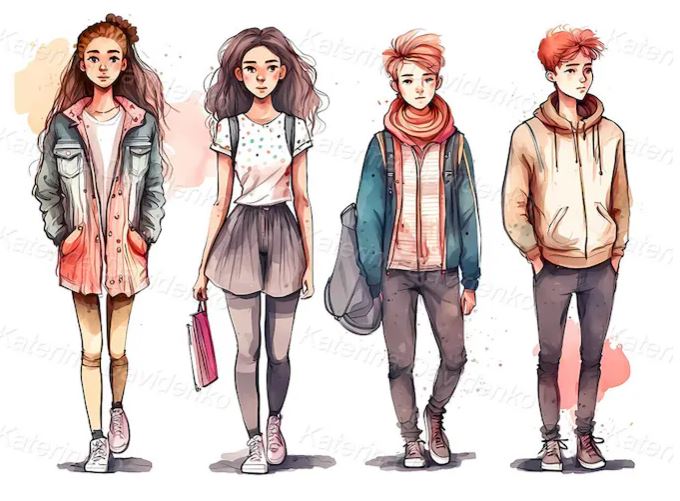Student Dress Codes

Elementary Dress Code
The students of the Halifax School District are expected to be aware of the importance of dressing appropriately and are urged to accept their responsibility in ensuring that dress is safe, clean, and appropriate. Distracting apparel can be detrimental to the educational process. The following guidelines serve as standards appropriateness of clothing:
Clothing must be worn as it was designed and intended.
Garments printed with words or pictures inappropriate for school will not be permitted.
Skirts or shorts should be an appropriate length for school.
Tops that expose the midriff, low-cut tops that expose the chest area, see-through tops, camisoles, halter tops, and tops with spaghetti straps may not be worn unless they are under another shirt that will remain on all day.
Shoes must be worn at all times. Slippers and shoes with wheels are prohibited. Flip flops and sandals without a back are discouraged.
The following are not to be worn indoors: coats, gloves, hats, caps, winter scarves, bandanas, hoods, and sunglasses.
The school staff and administration will make the final interpretation as to what is distracting. Students in violation of the above guidelines will be asked to alter their clothing immediately. Parents may be contacted to supply suitable clothing.
Physical Education Dress Code
Students are not permitted to wear jewelry while participating in Physical Education classes. Jewelry includes but is not limited to, rings, watches, bracelets, earrings, and necklaces. Jewelry should be taken off prior to leaving the classroom to attend Phys. Ed. class. The only reason for this policy is injury prevention, not only to oneself but to others as well.
There are exceptions to this policy. Any student may wear any piece of jewelry provided that the student has a note from a parent or guardian requesting that the jewelry not be removed. Acceptable reasons might include bracelets or necklaces bearing important health information (such as diabetes or asthma), or recently pierced earrings where studs must be worn for a minimum period of time. If there is no note requesting that the
jewelry not be removed, it must come off. The purpose of the parental note (which will be kept on file) is to alleviate any injury liability on the part of the Physical Education Instructor.
All students are required to wear sneakers, socks, and pants/shorts (no dresses or skirts) to each Phys. Ed. class. This, too, is purely for safety. Sneakers should not be of the slip-on variety and must have a way to tighten (shoe strings and Velcro are acceptable). This is part of the student’s PE grade. Provisions can be made for students who do not have access to sneakers.
NOTE: Students are made aware of this policy during their initial physical education class session each school year.
Music Class Dress Code
All students are required to wear sneakers or flat, non-platform shoes (with a back strap to tighten) (shoe strings and Velcro are acceptable). Students wearing footwear that is inappropriate for music class will be asked to sit out during the game, dance, or activity that requires movement. This will affect the student’s music grade. Provisions can be made for students who do not have access to sneakers. Any sneaker that would be appropriate for physical education class would also be appropriate for music class.
Middle School Dress Code
School attire must adhere to the guiding principles of being safe, not causing disruption, and being modest/moral. The following guidelines serve as standards determining the appropriateness of clothing:
Clothing must be worn as it was designed and intended as understood by administration.
Messages on clothing which are vulgar, have sexual connotations, or are offensive, or which advertise or advocate the use of tobacco, alcohol or drugs are inappropriate for school.
Shorts, skirts, and dresses need to be at a length where students can move, sit, and walk without risk of showing undergarments.
Pants, skirts, and shorts should not be worn low enough to expose undergarments or the student’s backside. Tops that expose the midriff, low cut tops that expose the chest area, see-through tops, tank tops, camisoles, halter tops, and tops with spaghetti straps may not be worn unless they are under another shirt that will remain on all day. Shirts should cover the shoulder.
Holes are permitted if they are not too high on the leg. If holes are too revealing, it is expected that leggings, tights, or shorts be worn underneath. Tape or other materials that stick on this skin are not allowed to cover holes in jeans.
Shoes must be worn at all times.
The following are not to be worn indoors:
gloves, hats, caps, bandanas, hoods, sunglasses, or other head gear.
Administration makes the final interpretation based on the guiding principles. Students in violation of the above guidelines may be asked to alter their clothing. Multiple dress code infractions could result in school disciplinary actions. Parents/guardians may be contacted to supply suitable clothing.


High School Dress Code
Follow 3 Guiding Principles:
Your attire must:
1. Be SAFE.
2. Not Cause DISRUPTION
3. Be MODEST & MORAL
FAQ:
Q: Who decides if something conforms to the Guiding Principles?
A: The High School Office
Q: What happens if it is determined something I am wearing does not conform to the Guiding Principles?
A: You will be told what needs to change to conform to the Guiding Principles, and you will be given the opportunity to modify it.
Q: What happens if I refuse to modify my attire to conform to the Guiding Principles?
A: You will remain in the High School Office. The principal will call home with you to obtain parent / guardian support in helping you to make the right decision.
Q: What happens if I am “dress coded” multiple times?
A: The principal will work with you and your parent / guardian to help you work towards routine dress code compliance. School discipline may be part of this process.
Q: What happens if I do not agree with the High School Office for how to conform to the Guiding Principles?
A: You may choose rigid conformity to the Alternative Dress Code offered below
Alternative Dress Code (Rigid Conformity Required)
Clothing must be worn as it was designed and intended, as understood by Administration.
Messages on clothing which are vulgar, have sexual connotations, or are generally offensive, or which advertise or advocate the use of tobacco, alcohol or drugs are inappropriate for school.
Skirts or shorts that come to the knee or below when a student is standing are appropriate. Pants, skirts, and shorts should also not be worn low enough to expose undergarments or the student’s backside.
Tops that expose the midriff, low cut tops that expose the chest area, see-through tops, tank tops, camisoles, halter tops, and tops with spaghetti straps may not be worn unless they are under another shirt that will remain on all day. Shirts should cover the shoulder.
Holes in clothing should not expose anything above the knee.
Students may not wear pajama tops or bottoms to school.
Shoes must be worn at all times. Slippers and shoes with wheels are prohibited. Flip flops and sandals are permitted.
The following are not to be worn indoors: gloves, hats, caps, winter scarves, bandanas, hoods, sunglasses, or other head gear. Hair bands, headbands, and fashion scarves used as they are intended are acceptable.
Outerwear such as coats and jackets must be placed in the locker for storage.
Any chains, metal items attached to leather, or any apparel that could be determined to be inappropriate or dangerous (e.g., necklace with spikes) are prohibited.
Other restrictions may be imposed as is determined necessary by the Administration.
